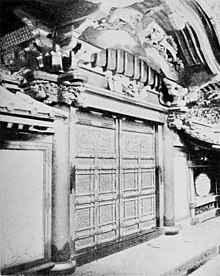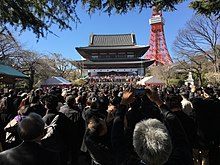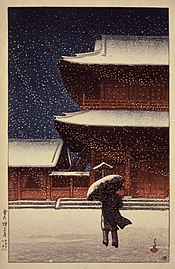
Jōdo Shinshū, also known as Shin Buddhism or True Pure Land Buddhism, is a school of Pure Land Buddhism founded by the former Tendai Japanese monk Shinran.

Tokugawa Iemochi was the 14th shōgun of the Tokugawa shogunate of Japan, who held office from 1858 to 1866. During his reign there was much internal turmoil as a result of the "re-opening" of Japan to western nations. Iemochi's reign also saw a weakening of the shogunate.

Jōdo-shū, also known as Jōdo Buddhism, is a branch of Pure Land Buddhism derived from the teachings of the Japanese ex-Tendai monk Hōnen. It was established in 1175 and is the most widely practiced branch of Buddhism in Japan, along with Jōdo Shinshū. In the general classification of Buddhism in Japan, the Jōdo-shū, the Jōdo Shinshu, the Ji-shu and the Yuzu Nembutsu shu are collectively classified into the lineage of Jōdo Buddhism.

Shiba Park is a public park in Minato, Tokyo, Japan built around the temple of Zōjō-ji.

Hasui Kawase was a Japanese artist who was one of 20th century Japan's most important and prolific printmakers. He was a prominent designer of the shin-hanga movement, whose artists depicted traditional subjects with a style influenced by yōga. Like many earlier ukiyo-e prints, Hasui's works were commonly landscapes, but displayed atmospheric effects and natural lighting.
Abe Masatsugu was a daimyō in early Edo period, Japan.

Hōtōzan Hōju-in Daishin-ji (宝島山峯樹院大信寺), abbreviated Daishin-ji, is a Buddhist temple of the Jōdo sect in Minato, Tokyo, Japan. In 1611, the founder, Ryō-kō Shōnin, was given land for the temple in Minami Hatchōbori by the Tokugawa shogunate. The temple was originally named Hōtōzan. In 1635, it was relocated to its present site in Mita 4 chōme by order of the government, to accommodate the continuing expansion of Edo. In 1636, Ishimura Genzaemon, considered the first shamisen craftsman in Edo, was buried in the temple. From Ishimura Omi, the graves of eleven generations of the family were also constructed there. For this reason, the temple is sometimes nicknamed "The Shamisen Temple."

Tōeizan Kan'ei-ji Endon-in (東叡山寛永寺円頓院) is a Tendai Buddhist temple in Tokyo, Japan, founded in 1625 during the Kan'ei era by Tenkai, in an attempt to emulate the powerful religious center Enryaku-ji, in Kyoto. The main object of worship is Yakushirurikō Nyorai (薬師瑠璃光如来).
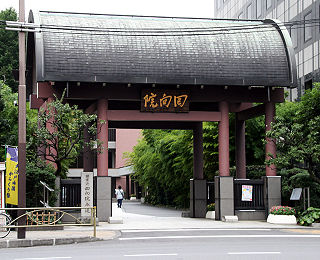
Ekō-in (回向院), also known as Honjo Ekō-in, is a Jōdo-shū Buddhist temple in Ryōgoku, Tokyo. The formal name of the temple is Shoshūzan Muen-ji Ekō-in, reflecting its founding principle of Pariṇāmanā, or the spreading of Amida Buddha's benevolence to all souls of all living creatures.

Tenshōzan Renge-in Kōmyō-ji (天照山蓮華院光明寺) is a Buddhist temple of the Jōdo sect in Zaimokuza, near Kamakura, Japan, the only major one in the city to be close to the sea. Kōmyō-ji is number one among the Kantō Jūhachi Danrin (関東十八檀林), a group of 18 Jōdo temples established during the Edo period by Tokugawa Ieyasu, and dedicated to both the training of priests and scholarly research. It is also the sect's head temple for the Kantō region. In spite of the fact it is a Jōdo sect temple, Kōmyō-ji has several of the typical features of a Zen temple, for example a sanmon, a pond and a karesansui.

A bodaiji in Japanese Buddhism is a temple which, generation after generation, takes care of a family's dead, giving them burial and performing ceremonies in their soul's favor. The name is derived from the term bodai (菩提), which originally meant just Buddhist enlightenment (satori), but which in Japan has also come to mean either the care of one's dead to ensure their welfare after death or happiness in the beyond itself. Several samurai families including the Tokugawa had their bodaiji built to order, while others followed the example of commoners and simply adopted an existing temple as family temple. Families may have more than one bodaiji. The Tokugawa clan, for example, had two, while the Ashikaga clan had several, both in the Kantō and the Kansai areas.
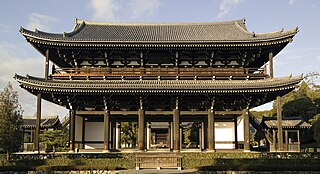
A sanmon, also called sangedatsumon, is the most important gate of a Japanese Zen Buddhist temple, and is part of the Zen shichidō garan, the group of buildings that forms the heart of a Zen Buddhist temple. It can be often found in temples of other denominations too. Most sanmon are 2- or 3-bay nijūmon, but the name by itself does not imply any specific architecture.

Nijūmon is one of two types of two-story gate presently used in Japan, and can be found at most Japanese Buddhist temples. This gate is distinguishable from its relative by the roof above the first floor which skirts the entire upper story, absent in a rōmon. Accordingly, it has a series of brackets (tokyō) supporting the roof's eaves both at the first and at the second story. In a rōmon, the brackets support a balcony. The tokyō are usually three-stepped (mitesaki) with tail rafters at the third step. A nijūmon is normally covered by a hip-and-gable roof.

The Hongan-ji Nagoya Betsuin (本願寺派名古屋別院) is a Jōdo Shinshū Buddhist temple located in Naka ward, Nagoya in central Japan.

The Taitoku-in Mausoleum was an Edo period mausoleum for Shōgun Tokugawa Hidetada. It was located within the grounds of Zōjō-ji in Tokyo.
Kanō Kazunobu was a Japanese painter of the Kanō school.

Shiba Tōshō-gū (芝東照宮) is a Tōshō-gū Shinto shrine located in the Minato ward of Tokyo, Japan.
Kantō Jūhachi Danrin is generic term for eighteen Jōdo-shū temples located in Kantō region that were recognized as danrin by Tokugawa shogunate.

Genkū-ji (源空寺), is a Buddhist temple located in the Higashiueno neighborhood of Taitō-ku, Tokyo, Japan. The temple belongs to the Jōdo-shū sect of Japanese Buddhism and its honzon is a statue of Hōnen.

Reigan-ji (霊巌寺), is a Buddhist temple located in Kōtō-ku, Tokyo, Japan. The temple belongs to the Jōdo-shū sect of Japanese Buddhism and its honzon is a statue of Amida Nyōrai





